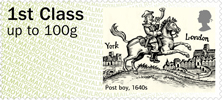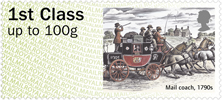Post & Go : Royal Mail Heritage: Transport
2016 (February 17 2016)Stamps
Post boy, 1640s
1stImage preview by Royal Mail
Post boys could be of almost any age and carried messages between relay points some 20 miles (32km) apart, the distance a horse could travel at speed before being replaced. Post boys kept to time and carried a horn, blown periodically, to warn of their approach.
Mail coach, 1790s
1stImage preview by Royal Mail
The first mail coach ran between Bristol and London on 2 August 1784. At the time, coaches were among the swiftest vehicles on the road. The only postal employee on board was the heavily armed mail guard. The last London-based mail coach ran in April 1846.
 Mail coach at Wikipedia
Mail coach at Wikipedia
Falmouth packet ship, 1820s
1stImage preview by Royal Mail
The earliest packet ships were designed for speed rather than security and were subject to many hazards, including poor seas and the possibility of being attacked by pirates. Falmouth became an important port for ships sailing to the West Indies and the Mediterranean.
 Packet boat at Wikipedia
Packet boat at Wikipedia
Travelling Post Office, 1890s
1stImage preview by Royal Mail
The first purpose-built Travelling Post Office (TPO), in which mail was sorted en route, ran on 20 January 1838. Many of the trains exchanged mail pouches without stopping via trackside bag exchange apparatus. The last exchange took place in 1971. Today, mail still travels in sealed train carriages.
 Travelling Post Office, 1890s at Wikipedia
Travelling Post Office, 1890s at Wikipedia
Airmail, 1930s
1stImage preview by Royal Mail
The world’s first scheduled airmail service began on 9 September 1911. The use of airplanes for long-distance transport of mail increased significantly during the 1920s and 1930s. Originally intended for Imperial Airways’ European mail routes, HP 45 G-AAXE Hengist first flew on 8 December 1931.
Royal Mail Minivan, 1970s
1stImage preview by Royal Mail
Minivans were purchased in large numbers in the 1970s following the demise of the Morris Minor. They were ideal for smaller collection and delivery duties in towns, but low height and limited ground clearance made them less suitable for rural deliveries.













